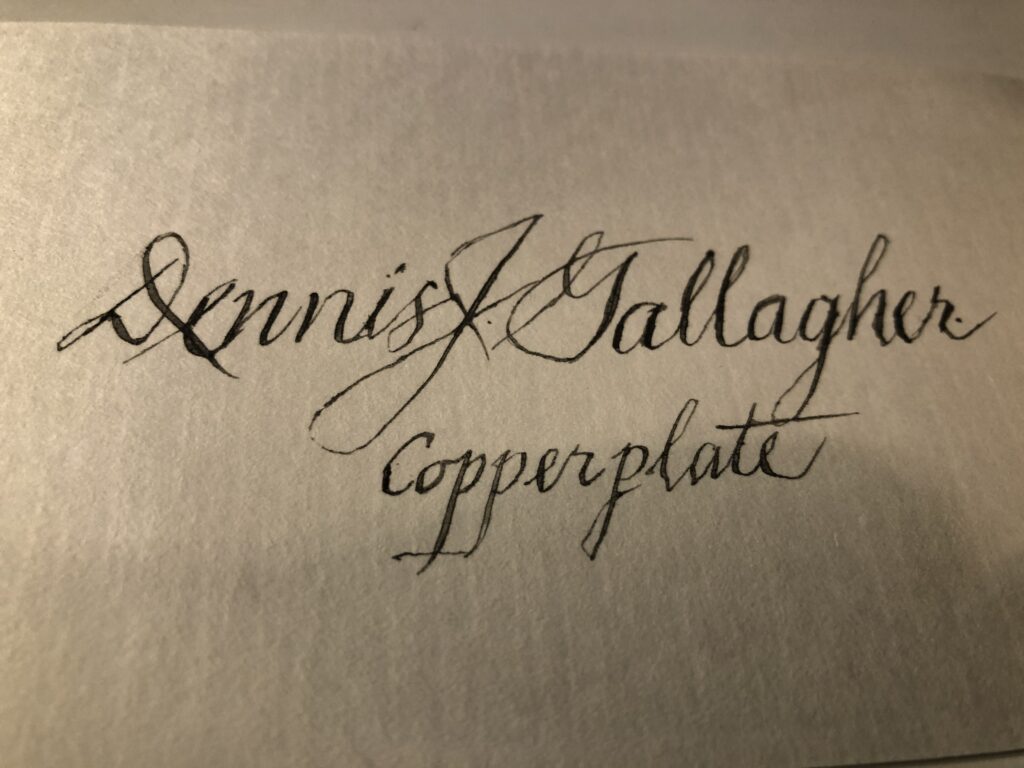
My beloved son, Daniel Patrick Gallagher, in whom I am well pleased, and I always fill out our ballots together. This has become a special bonding time in our family, making sure we study the ballot together. We then take time to fill out the circles on our individual ballots. Like the Kennedy family dinners, we discuss the pros and cons of each ballot: the measures and the candidates. That’s why we have both decided to vote NO on amendment B on Colorado’s November ballot. As we filled out our primary ballots, I told him, “Be sure to sign neatly so that the election folks will be able to read your signature.” He responded quickly, “Dad, if I write neatly or in cursive, the election folks will not believe it’s me voting. Unlike you, I did not take cursive in school, Dad.” He was right and I told him he should sign his signature as he always does, not as legible as it could be, as it is his “John Hancock.”
When we had this discussion, I thought of John Hancock who signed his name in a larger than normal script on the parchment document in 1776 which changed the course of history by splitting us off from King George. Calligraphers call his writing style, copperplate. That means a flowing writing style with fine light lines on all the up strokes and a thicker darker lines on all the down strokes. John told his fellow rebels as they signed the Declaration of Independence that he wanted his signature to be large enough for King George not to have to use his spectacles when reading his name. History rewarded John for his courage in signing the Declaration of Independence. And if the British ever caught him he would receive capital punishment for his being an American traitor to the British King. But for his trouble John’s famous copperplate signature on the Declaration even became synonymous with the word for a signature itself. “Put your John Hancock here,” means “sign your signature here.”
During this electronically mediated communication age and with our computers dictating digital and electronic signatures, the British would have trouble reading the sloppy non-cursive signatures of those rebels trying to throw off mother England and form a new nation. And I suppose you know that schools don’t teach cursive writing anymore and they have not taught handwriting for many years. The schools simply teach printing but not writing. Though there are a few parochial schools which still teach cursive and in some districts, not Denver’s, there is some support for bringing cursive and handwriting back into the elementary curriculum.

I remember my first grade teacher, Sr. Marcellus, a wonderful Sister of Loretto, gave me a great gift by teaching me copperplate. When I was in grade school at Holy Family in North Denver, the desks still had inkwells in the upper right hand corner of each well-worn desk. We kids all wanted the new medium, fountain pens with ink wells inside the pen. The nuns discouraged ball point pens, however, because they believed the ball points were less precise than the trusty and bulky fountain pens as they worked their way across the pages filling the papers with cursively connected written letters. We had a writing practice period to improve our handwriting every day. I always enjoyed those classes and that’s what got me interested in calligraphic writing way back then. Sr. Marcellus taught me pointed pen ink dipping copperplate. I owe her a thousand thanks
It was in this background that year’s later I received a letter from former Senator Gary Hart whose signature appeared in the upper right hand corner of his envelope. The frank was an old custom. The post office delivered all signed envelopes from Senate and House members with signatures in the corner. Frank comes from Italian “francare” meaning ” to be free.” Senators got to send out mail on the frank, or free.
On the envelope I received, Gary’s signature boasted a legible “G” for his first name followed by a line which dropped down for the “y.” His last name had a printed “H” followed by a line with a small “t” for the final letter. You could not read the name. I saw Gary at a meeting of the North Denver Democrats and told him, “Gary, you are missing out on a lot of good name identification on your mail frank.” I reminded him of the famous slogan of Marshall McLuhan, the great media guru “The Medium is the Message.” I told him the voters and citizens can’t read your name because it is perhaps written too fast and unclear. Gary took my advice and just printed his signature as I recall, no connective cursive, but legible to the post office and voters. Some time later, reporter and commentator Camille Paglia wrote an extensive biographical piece on him in Atlantic and indicated she thought he must have experienced some sort of psychological crisis to change his name on the frank. No, Camille, he was simply following my advice on better name identification on the federal envelope frank signature.
Finally, I recall teaching a calligraphy class, as I often did before the Coronavirus, at Skinner Middle School a few years back. One young middle schooler turned to his girlfriend and announced, “This is cool and I can’t wait to do graffiti in calligraphy, thank you, Senator Gallagher.” I thought, well, I guess we might at least be able to read the often illegible graffiti. I was teaching Italic calligraphy that day, writing that leans to the right, that’s why Italic letters always lean slightly to the right.
After sharing the above reflection, I am worried that the hoards of Trump poll watchers which the president is sending into voter precincts will spring on the lack of cursive signatures on ballots to suppress even more ballots during this next election. Voters must be careful to write the same signature which is on file and Denver’s election office. Judges complain they often can’t read the names on the ballots, but they are signatures nonetheless and non cursive as they may be. And any complaint about a ballot has to go through a chance to be corrected by the voter.
I hope cursive and copperplate come back into the school curricula. I know the students would feel more connected as cursive letters are connected. Give me your opinion on all this: dgallag954@aol.com.
The Honorable Dennis Gallagher is a former city auditor, city councilman, state senator and state representative. He’ll be sharing thoughts and stories from North Denver’s past and future in his reoccuring column in The Denver North Star.

I absolutely agree cursive should be taught. As mail-in balloting as shown, a signature is important. Writing in cursive is also faster than printing, especially when taking notes. What if your electronic notebook isn’t properly charged? Being too reliant on electronic devices could become a handicap in some instances..
As always, we have informative and interesting information from Dennis. . He is a rich part of your publication.